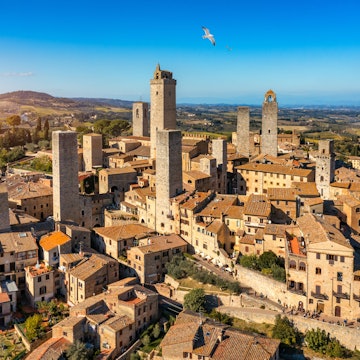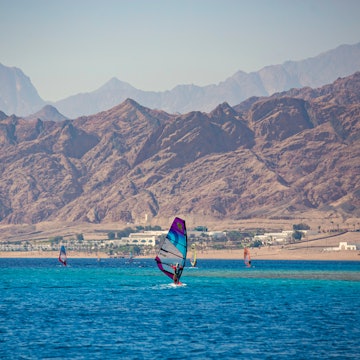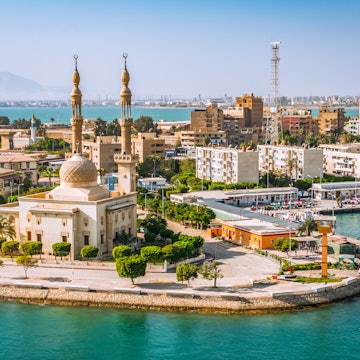

Avoid the crowds with these lesser-known, yet spectacular, destinations around Egypt © givaga / Shutterstock
One of the cradles of civilization, Egypt has a bounty of ancient monuments that’s unparalleled anywhere else in the world.
The names of Egypt’s big-hitters – the Pyramids of Giza, the Sphinx, King Tut and the Valley of the Kings – are known by millions around the globe who might never even set foot in the country.
Because these historic places have lured foreign travelers to Egypt for literal millennia – ancient Greek and Roman tourists carved graffiti into the walls of tombs in the Valley of the Kings – the well-trodden path to see them is hardly a secret, and you’ll rarely find yourself alone on a visit.
First-time visitors to Egypt tend to follow a standard route from Cairo to Luxor and end their trip in Aswan. While we’re certainly not advocating skipping any of the best places to visit in Egypt, returning travelers who are looking to dig deeper and have unique experiences will find this incredible country has plenty more to discover beyond the scripted itinerary.
Many beautiful and lesser-visited areas of Egypt, such as Siwa Oasis in the far Western Desert and parts of the Sinai Peninsula, are open to and warmly welcome travelers, but some western governments, including the US Department of State, advise against travel in these regions. Check your government’s travel advice before your trip, as well as with your accommodations and local tour operators when you arrive.
Here’s how to get off the beaten track on your trip to Egypt.

1. If you like the Pyramids of Giza, try Saqqara
It’s impossible not to be awestruck when you see the iconic Pyramids of Giza with your own eyes for the first time.
You’ll likely also be struck by the sheer spectacle of humanity here: passengers emptying out of oversized buses, would-be tour guides touting their services, camel- and horse-drivers ready to take you for a ride (financially and otherwise), the surprisingly sticky interior of the pyramids glistening with the sweat and humid breath of those who dare enter.
But the Pyramids of Giza are far from the only structures of their sort on this section of the Nile’s west bank. Slightly to the south is Saqqara, the necropolis of ancient Egypt’s first capital of Memphis and an active burial ground for more than 3500 years.
Saqqara is Egypt’s largest and most fruitful archaeological site, and groundbreaking discoveries are still being made here, from wooden coffins, mummies and bronze statues to pots of cheese from the 26th Dynasty.
The Step Pyramid of Djoser is the oldest pyramid in Egypt and the most ancient stone structure in the entire world, and its interior reopened in 2020 after 14 years of renovations.
Despite the short drive from Giza, Saqqara sees fewer visitors, and the numbers drop even further for the nearby Red Pyramid and Bent Pyramid. Seeing them all paints a clear picture of the ancient Egyptians’ architectural progress as they moved from stepped sides to smooth.

2. If you like Khan Al Khalili, try Manial Palace
Cairo’s chaotic marketplace of Khan Al Khalili is a medieval maze of shops that line dozens of narrow cobbled alleyways and spill through keyhole arches. You can buy just about anything here: clothing, rugs, tea sets, gold jewelry, tacky souvenirs, metal lanterns and even hookahs shaped like beloved Egyptian singer Umm Kulthum.
If you’ve picked up a haul of homewares and want some interior design inspo, visit Manial Palace to find one of the capital’s best-kept secrets and see Cairo off the beaten path.
Built by Prince Mohammed Ali Tewfik starting in 1899, this once-royal residence is a mashup of Ottoman, Persian, Andalusian and European rococo that’s left every surface dripping with color, gilt and texture.
The walls are covered in gorgeous tiles, and some of the ceilings are made from intricately carved wood and muqarnas (stalactite vaulting). The sun glints through panes of vividly hued window glass, spilling colorful constellations on the huge Turkish carpets. Manial Palace is easily one of the most beautiful and unusual things to do in Cairo.

3. If you like Karnak, try Abydos
Luxor’s temple complex of Karnak is one of the world’s largest religious sites, and clocking in at 81 hectares (200 acres), it’s even bigger than Vatican City and perhaps just as visited. While the temple at Abydos is nowhere near as big of a site as Karnak, a visit might be just as spiritual with a fraction of the tourists.
Abydos is closely associated with Osiris, god of the afterlife, because ancient Egyptian myth says this spot is where the deity’s head landed after Osiris was chopped up and scattered across Egypt by his jealous brother Seth. It was a place of pilgrimage and burial, and some still believe that this area holds mysterious powers.
The Temple of Seti I is an impressive, well-preserved structure, with an excellent number of painted bas-reliefs covering the walls and ceiling and an enchanting hypostyle hall darkened by the temple’s in-situ ceiling.
Karnak’s Great Hypostyle Hall was an addition by Seti I, and you can reach the pharaoh’s temple in Abydos on a day trip from Luxor with a company such as Magic Carpet Travel.
4. If you like the Valley of the Kings, try the “premium” valley tombs or Deir El Medina
Seeing the raids of their predecessors’ tombs, the New Kingdom pharaohs (1550 BCE to 1069 BCE) elected to enter the afterlife from a new, top-secret location: below the pyramid-shaped peak of Al Qurn on the west bank of Thebes (modern-day Luxor).
But when gold, precious gifts and a lifetime of treasures are involved, a place doesn’t stay hidden for long. Tomb robberies in the Valley of the Kings started not long after the pharaoh’s death, and some of the tombs stood wide open in antiquity, inviting in visitors of all sorts.
A rotating selection of tombs remains open to travelers today, but a tiered pricing structure keeps some of the most beautiful burial chambers nearly empty.
The two “premium” tombs, those of Seti I in the Valley of the Kings and Nefertari in the Valley of the Queens, command the highest ticket prices of any tourist attraction in Egypt (LE1000 for Seti I, about US$51, and LE1400 for Nefertari, about USD$72), but seeing the bas reliefs of gods, goddesses, pharaohs and hieroglyphic text from the Book of the Dead and other religious spells painted in seemingly fresh strikingly vibrant colors is priceless.
Exploring Luxor off the beaten path might seem difficult given its concentration of must-see monuments, but this wonderful open-air museum of a city has plenty of hidden corners ignored by most visitors.
The artisans and builders who constructed and decorated the royal tombs lived in the once bustling village of Deir El Medina and used their incredible skills to create and paint their own tombs in a highly elaborate fashion, but it hardly sees any activity now.

5. If you like Edfu, try Dendera
The Temple of Horus at Edfu is one of the most intact temples in Egypt, its sanctuaries and side chambers cast in atmospheric shadows thanks to the preserved ceiling. This grand structure is dedicated to Horus, the falcon-headed protector god, whose wife was Hathor, the goddess of motherhood and joy.
During the ancient annual Festival of the Beautiful Reunion, a statue of Hathor was loaded onto a boat and carried along the Nile to Edfu to be reunited with Horus.
While Edfu is a standard stop on Nile cruises, the Temple of Hathor at Dendera is often left off despite its close proximity to Luxor.
A few cruise companies, such as Viking, do include a visit to this gorgeous temple, where you can see how the carefully painted ceilings have been brought back to life after a recent renovation – look out for the black sooty square to see its previous state. In a chamber on the roof is the famous Dendera Zodiac (sadly a replica; the original is in the Louvre in Paris).

6. If you like cruising on the Nile, try going on a dahabiya
With up to five floors, multiple restaurants and bars, a top-deck pool, and sometimes a gym and spa, it’s no surprise that Nile cruisers are called “floating hotels.”
But these hulking vessels aren’t the only way to get out on the river, and for a more intimate experience, sign up for a dahabiya cruise with an outfitter like Nour El Nil.
Dahabiyas are boats designed in a traditional style, made of wood and set in motion by unfurling elegant double lateen sails instead of switching on an engine.
Because of their smaller size and their smaller passenger count (usually no more than 15), dahabiyas can stop at ancient sites that larger vessels bypass, such as the Temple of Khnum at Esna and the off-the-beaten-track painted tombs at El Kab, as well as give you a more personal experience of the Nile, from scheduled swimming stops to meeting residents of rural villages.
7. If you like Abu Simbel, try a cruise on Lake Nasser
Many visitors to Egypt say that the Great Temple at Abu Simbel, fronted by gigantic statues of the seated pharaoh, is their favorite, thanks to its over-the-top architecture (a signature of Ramses II), its serene lakeside location and incredible tale of rescue from the rising waters caused by the construction of the Aswan High Dam.
The result of the dam was Lake Nasser, one of the largest artificial bodies of water in the world. Just a few companies operate cruises on the lake, which deliver you to little-seen monuments, most of which are otherwise unvisitable, as well as allowing you to bask in the glory of Abu Simbel long after all the other visitors have had to start the journey back to Aswan.
8. If you like sailing on the Nile at sunset, try an overnight felucca
Going sailing at sunset on a felucca, a small traditional sailboat, is a delightful way to see out the day in Nile-side cities such as Cairo, Luxor and Aswan, and if you want to have even more up-close experiences on the legendary river, you can go on a one-night or multi-night felucca trip.
It’s an adventure akin to camping, with basic meals cooked on board. You sleep under blankets at the back of the boat, and the distance that you travel is entirely wind-dependent. It’s one of the most beautiful forms of slow travel, harking back to a long-gone era.
Trips like this are best arranged through a reputable company, such as Aswan Individual, which uses reliable and experienced Nubian captains.
















